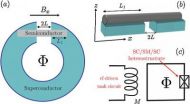(Press-News.org) Tampa, FL (Oct. 8, 2012) -- The chaperone protein Grp94 can interfere with the clearance of another protein known to cause the glaucoma when mutated, a new study led by researchers at the University of South Florida has found. Using a cell model, the researchers also demonstrated that a new specific inhibitor of Grp94 facilitates clearance of the genetically-defective protein, called myocilin, from cells.
Reported online this month in JBC (The Journal of Biological Chemistry), the discoveries could lead to a new treatment for some hereditary cases of glaucoma, an eye disease that is a leading cause of blindness, said principal investigator Chad Dickey, PhD, associate professor of molecular medicine at the USF Health Byrd Alzheimer's Institute.
"When mutated, the glaucoma-causing protein becomes toxic to a cell network known as the trabecular meshwork cells that regulate pressure within the eye," Dickey said. "Once these cells die, the ocular pressure increases, causing glaucoma."
Genetic defects of myocilin account for approximately 8 to 36 percent of hereditary juvenile-onset glaucoma and 5 to 10 percent of adult-onset hereditary glaucoma.
The researchers suggest that mutant myocilin, triggered by an interaction with the chaperone Grp94, is highly resistant to degradation, thus clogging the protein quality control pathway and subverting efficient removal of the glaucoma-causing protein. So, the development of targeted therapies to inhibit Grp94 may be beneficial for patients suffering from myocilin glaucoma.
### USF researchers from the Department of Molecular Medicine and College of Pharmacy worked on the study, which was supported by the National Institutes of Health and the American Health Assistance Foundation. They collaborated with scientists from the National Eye Institute, Georgia Institute of Technology and University of Kansas.
Article citation:
"Grp94 triage of mutant myocilin through ERAD subverts a more efficient autophagic clearance mechanism;" Amirthaa Suntharalingam, Jose F. Abisambra, John C. O'Leary III, John Koren III, Bo Zhang, Myung Kuk Joe, Laura J. Blair, Shannon E. Hill, Umesh K. Jinwal, Matthew Cockman, Adam S. Duerfeldt, Stanislav Tomarev, Brian S.J. Blagg, Raquel L. Lieberman, and Chad A. Dickey; JBC: The Journal of Biological Chemistry; published Oct. 3, 2012 as manuscript M112.384800.
USF Health's mission is to envision and implement the future of health. It is the partnership of the USF Health Morsani College of Medicine, the College of Nursing, the College of Public Health, the College of Pharmacy, the School of Biomedical Sciences and the School of Physical Therapy and Rehabilitation Sciences; and the USF Physician's Group. The University of South Florida is a global research university ranked 50th in the nation by the National Science Foundation for both federal and total research expenditures among all U.S. universities.
Chaperone protein subverts removal of glaucoma-causing protein
Study finds inhibiting the protein, Grp94, could offer new treatment for the sight-robbing eye disease
2012-10-09
ELSE PRESS RELEASES FROM THIS DATE:
Topological superconductors
2012-10-09
If quantum computers are ever going to perform all those expected feats of code-breaking and number crunching, then their component qubits---tiny ephemeral quantum cells held in a superposition of internal states---will have to be protected from intervention by the outside world. In other words, decoherence, the loss of the qubits' quantum integrity, has to be postponed. Now theoretical physicists at the Joint Quantum Institute (JQI) and the University of Maryland have done an important step forward to understand qubits in a real-world setup. In a new study they show, ...
Bioenergy - The broken promise
2012-10-09
Biofuels are going to save us from climate threats and the oil crisis, while at the same time providing an opportunity to the smallholder farmers of the world. Hopes are high, but completely unrealistic. It is like trying to push a square peg into a round hole, according to a current thesis at Linköping University.
Bioenergy could replace fossil fuels and solve the looming energy crisis. Into the bargain, we will benefit from reduced greenhouse gas emissions. A further bonus could be that demand for biofuels gives a lift to smallholder farmers in poor countries, who would ...
Doubling up on advanced prostate cancer with PARP inhibitors
2012-10-09
A newly discovered function of PARP-1 could be the key to more effective therapeutics to treat advanced prostate cancer patients, a recent preclinical study published in Cancer Discovery by Jefferson's Kimmel Cancer Center researchers suggests.
The team, led by Karen E. Knudsen, Ph.D., Professor in the Departments of Cancer Biology, Urology, & Radiation Oncology at Thomas Jefferson University, found that functions of PARP-1 not only include DNA damage repair but also androgen receptor (AR) regulation in advanced prostate cancer growth and progression. PARP inhibition ...
Chronic kidney disease alters intestinal microbial flora, UCI study finds
2012-10-09
Irvine, Calif., Oct. 9, 2012 – Chronic kidney disease changes the composition of intestinal bacterial microbes that normally play a crucial role in staving off disease-causing pathogens and maintaining micronutrient balance, according to UC Irvine researchers.
This profound alteration of the gut microbial population may contribute to the production of uremic toxins, systemic and local inflammation, and nutritional abnormalities present in patients with advanced renal disease, they said.
Study leader Dr. N.D. Vaziri of the UCI School of Medicine's Division of Nephrology ...
Drawing a line, with carbon nanotubes
2012-10-09
CAMBRIDGE, Mass. -- Carbon nanotubes offer a powerful new way to detect harmful gases in the environment. However, the methods typically used to build carbon nanotube sensors are hazardous and not suited for large-scale production.
A new fabrication method created by MIT chemists — as simple as drawing a line on a sheet of paper — may overcome that obstacle. MIT postdoc Katherine Mirica has designed a new type of pencil lead in which graphite is replaced with a compressed powder of carbon nanotubes. The lead, which can be used with a regular mechanical pencil, can inscribe ...
Academic achievement improved among students active in structured after-school programs
2012-10-09
School-age children who participate in structured after-school activities improve their academic achievement, according to a new study from Southern Methodist University, Dallas.
The study by researchers in SMU's Simmons School of Education and Human Development measured academic performance of students enrolled in Boys and Girls Clubs of Greater Dallas.
"Boys and Girls Clubs of Greater Dallas and other structured programs are really having a positive impact," said Ken Springer, an associate professor. "We believe that the homework support that the clubs consistently ...
How cancer cells break free from tumors
2012-10-09
CAMBRIDGE, MA -- Although tumor metastasis causes about 90 percent of cancer deaths, the exact mechanism that allows cancer cells to spread from one part of the body to another is not well understood. One key question is how tumor cells detach from the structural elements that normally hold tissues in place, then reattach themselves in a new site.
A new study from MIT cancer researchers reveals some of the cellular adhesion molecules that are critical to this process. The findings, published Oct. 9 in Nature Communications, offer potential new cancer drug targets, says ...
Online attitudes predict individuals' compulsive and excessive Internet use and poor well-being
2012-10-09
Among the most popular questions addressed in online communication research is the extent to which Internet use leads to undesirable psychosocial outcomes such as depression and loneliness. Evidence suggests that certain motivations to communicate online can have negative consequences, as the Internet itself can, for some, serve as an object of compulsive use. Individuals' compulsive Internet use (CIU) refers to their inability to control, reduce, or stop their online behavior, while excessive Internet use (EIU) is the degree to which an individual feels that he or she ...
Preterm labor powerhouse therapy offers promise for inflammatory diseases
2012-10-09
Magnesium sulfate is given to many pregnant women to treat preterm labor and preeclampsia and was recently shown to prevent cerebral palsy; however little is known about how it works. Researchers at Case Western Reserve University School of Medicine recently discovered the mechanism by which magnesium reduces the production of cytokines. Cytokines are molecules responsible for regulating inflammation; they play a key role conditions, such as diabetes, obesity, atherosclerosis, asthma, and alcoholic liver disease and cirrhosis. Although the study related to pregnancy, inflammation ...
Rearing technique may bolster biocontrol wasp's commercial prospects
2012-10-09
This press release is available in Spanish. Two to three millimeters long, the parasitoid wasp Habrobracon hebetor is a top candidate for use in programs to biologically control Indianmeal moths and other stored-product pests. But despite the prospects for reduced insecticide use and product losses, the approach has yet to gain traction commercially, in part because of the lack of an efficient method of stockpiling the wasp.
But a team of scientists, including researchers from the U.S. Department of Agriculture (USDA), is working on the problem.
Through studies of an ...
LAST 30 PRESS RELEASES:
Making lighter work of calculating fluid and heat flow
Normalizing blood sugar can halve heart attack risk
Lowering blood sugar cuts heart attack risk in people with prediabetes
Study links genetic variants to risk of blinding eye disease in premature infants
Non-opioid ‘pain sponge’ therapy halts cartilage degeneration and relieves chronic pain
AI can pick up cultural values by mimicking how kids learn
China’s ecological redlines offer fast track to 30 x 30 global conservation goal
Invisible indoor threats: emerging household contaminants and their growing risks to human health
Adding antibody treatment to chemo boosts outcomes for children with rare cancer
Germline pathogenic variants among women without a history of breast cancer
Tanning beds triple melanoma risk, potentially causing broad DNA damage
Unique bond identified as key to viral infection speed
Indoor tanning makes youthful skin much older on a genetic level
Mouse model sheds new light on the causes and potential solutions to human GI problems linked to muscular dystrophy
The Journal of Nuclear Medicine ahead-of-print tip sheet: December 12, 2025
Smarter tools for peering into the microscopic world
Applications open for funding to conduct research in the Kinsey Institute archives
Global measure underestimates the severity of food insecurity
Child survivors of critical illness are missing out on timely follow up care
Risk-based vs annual breast cancer screening / the WISDOM randomized clinical trial
University of Toronto launches Electric Vehicle Innovation Ontario to accelerate advanced EV technologies and build Canada’s innovation advantage
Early relapse predicts poor outcomes in aggressive blood cancer
American College of Lifestyle Medicine applauds two CMS models aligned with lifestyle medicine practice and reimbursement
Clinical trial finds cannabis use not a barrier to quitting nicotine vaping
Supplemental nutrition assistance program policies and food insecurity
Switching immune cells to “night mode” could limit damage after a heart attack, study suggests
URI-based Global RIghts Project report spotlights continued troubling trends in worldwide inhumane treatment
Neutrophils are less aggressive at night, explaining why nighttime heart attacks cause less damage than daytime events
Menopausal hormone therapy may not pose breast cancer risk for women with BRCA mutations
Mobile health tool may improve quality of life for adolescent and young adult breast cancer survivors
[Press-News.org] Chaperone protein subverts removal of glaucoma-causing proteinStudy finds inhibiting the protein, Grp94, could offer new treatment for the sight-robbing eye disease

